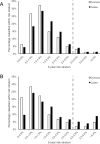Breast cancer risk prediction using a clinical risk model and polygenic risk score
- PMID: 27565998
- PMCID: PMC5033764
- DOI: 10.1007/s10549-016-3953-2
Breast cancer risk prediction using a clinical risk model and polygenic risk score
Abstract
Breast cancer risk assessment can inform the use of screening and prevention modalities. We investigated the performance of the Breast Cancer Surveillance Consortium (BCSC) risk model in combination with a polygenic risk score (PRS) comprised of 83 single nucleotide polymorphisms identified from genome-wide association studies. We conducted a nested case-control study of 486 cases and 495 matched controls within a screening cohort. The PRS was calculated using a Bayesian approach. The contributions of the PRS and variables in the BCSC model to breast cancer risk were tested using conditional logistic regression. Discriminatory accuracy of the models was compared using the area under the receiver operating characteristic curve (AUROC). Increasing quartiles of the PRS were positively associated with breast cancer risk, with OR 2.54 (95 % CI 1.69-3.82) for breast cancer in the highest versus lowest quartile. In a multivariable model, the PRS, family history, and breast density remained strong risk factors. The AUROC of the PRS was 0.60 (95 % CI 0.57-0.64), and an Asian-specific PRS had AUROC 0.64 (95 % CI 0.53-0.74). A combined model including the BCSC risk factors and PRS had better discrimination than the BCSC model (AUROC 0.65 versus 0.62, p = 0.01). The BCSC-PRS model classified 18 % of cases as high-risk (5-year risk ≥3 %), compared with 7 % using the BCSC model. The PRS improved discrimination of the BCSC risk model and classified more cases as high-risk. Further consideration of the PRS's role in decision-making around screening and prevention strategies is merited.
Keywords: Breast cancer; Cancer surveillance and screening; Risk assessment; Single nucleotide polymorphisms.
Figures



References
-
- Cummings SR, Tice JA, Bauer S, Browner WS, Cuzick J, Ziv E, Vogel V, Shepherd J, Vachon C, Smith-Bindman R, Kerlikowske K. Prevention of breast cancer in postmenopausal women: approaches to estimating and reducing risk. J Natl Cancer Inst. 2009;101(6):384–398. doi:10.1093/jnci/djp018. - PMC - PubMed
-
- Saslow D, Boetes C, Burke W, Harms S, Leach MO, Lehman CD, Morris E, Pisano E, Schnall M, Sener S, Smith RA, Warner E, Yaffe M, Andrews KS, Russell CA. American Cancer Society guidelines for breast screening with MRI as an adjunct to mammography. CA Cancer J Clin. 2007;57(2):75–89. - PubMed
-
- Moyer VA. Medications to decrease the risk for breast cancer in women: recommendations from the U.S. Preventive Services Task Force recommendation statement. Ann Intern Med. 2013;159(10):698–708. doi:10.7326/0003-4819-159-10-201311190-00717. - PubMed
MeSH terms
Grants and funding
LinkOut - more resources
Full Text Sources
Other Literature Sources
Medical

